Key takeaways:
- DNSSEC enhances the integrity of the Domain Name System by providing digital signatures to verify the authenticity of DNS responses, preventing issues like cache poisoning.
- The implementation of DNSSEC builds user trust and confidence in online interactions, crucial for businesses and organizations aiming to protect sensitive information.
- As remote work grows, reliable DNS and DNSSEC become essential to maintain seamless connectivity and secure user experiences in telecommunications.
- Future adoption of DNSSEC could standardize online security practices, making the internet safer and more resilient against cyber threats, while potentially leading to regulatory mandates for its use.

Understanding DNSSEC fundamentals
When I first delved into the intricacies of DNSSEC, I was surprised by its critical role in safeguarding the integrity of domain name system information. At its core, DNSSEC, or Domain Name System Security Extensions, adds a layer of security to the DNS by ensuring that the responses to your queries are authentic and unaltered. Can you imagine visiting a website only to discover that the information you received had been manipulated? That thought alone emphasizes why understanding DNSSEC is essential for any web user or administrator.
As I explored further, I learned that DNSSEC works by digitally signing data at various points within the DNS hierarchy. This means that when your browser queries a domain, DNSSEC provides a way to verify that the response comes from a legitimate source. It struck me how this mechanism is akin to checking a signature on a crucial document; without it, you’re left vulnerable to potential threats such as cache poisoning.
One day, while discussing these concepts with a friend who runs a small business, it became clear that many website owners may underestimate the importance of DNSSEC. I realized how this misunderstanding could endanger their online presence. Have you considered how often people trust what they see online without questioning its source? This reflection reinforced my belief that educating others on DNSSEC fundamentals is vital for fostering a more secure online environment.
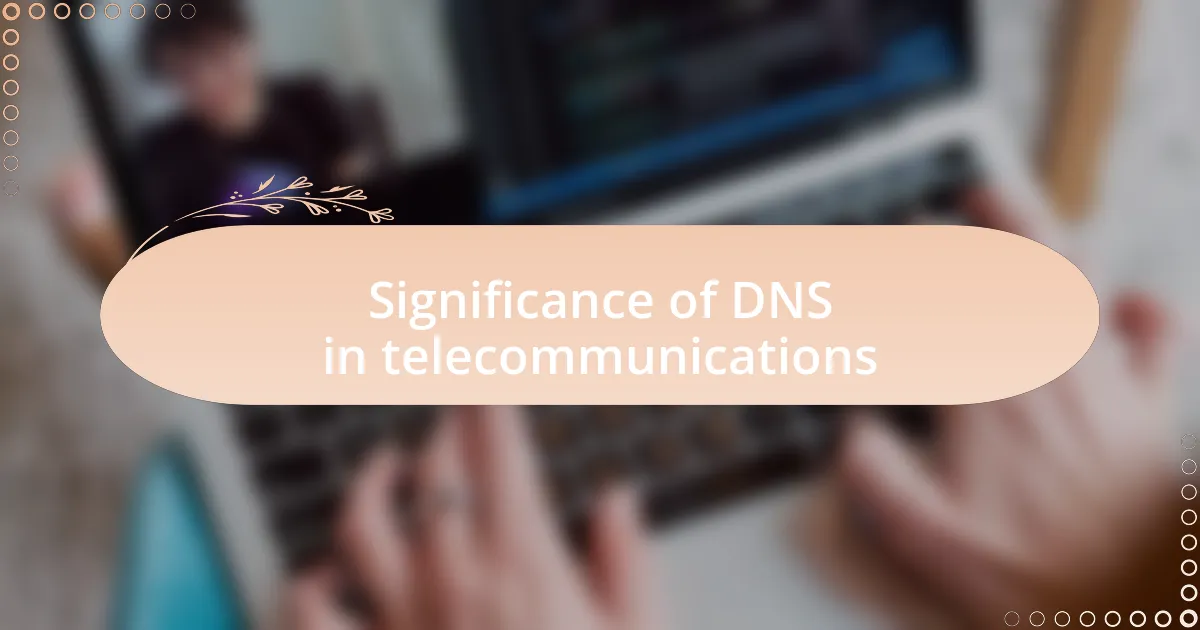
Significance of DNS in telecommunications
The Domain Name System (DNS) plays a pivotal role in telecommunications, acting as the backbone that translates human-readable domain names into IP addresses. When I first started working on network configurations in my early career, I quickly realized how much we rely on DNS to connect users to their desired content seamlessly. Have you ever tried to remember a series of numbers while browsing? This is why DNS is invaluable; it streamlines communication, making the internet intelligible and accessible to everyone.
In telecommunications, latency and reliability are crucial. The responsiveness of DNS impacts these factors significantly. I recall a project where a slow DNS response caused frustrating delays in service—a less-than-ideal experience for users. It’s fascinating how something as seemingly simple as a DNS lookup can have such significant implications for user experience and overall network performance.
Moreover, as remote work and digital services grow, the demand for efficient DNS resolution becomes even more critical in telecommunications. I often reflect on the challenges my team faced during peak traffic times when DNS failures resulted in downtime for clients. It made me acutely aware that a reliable and secure DNS is not just an option; it’s a necessity in keeping both businesses and their customers connected in an increasingly digital world.
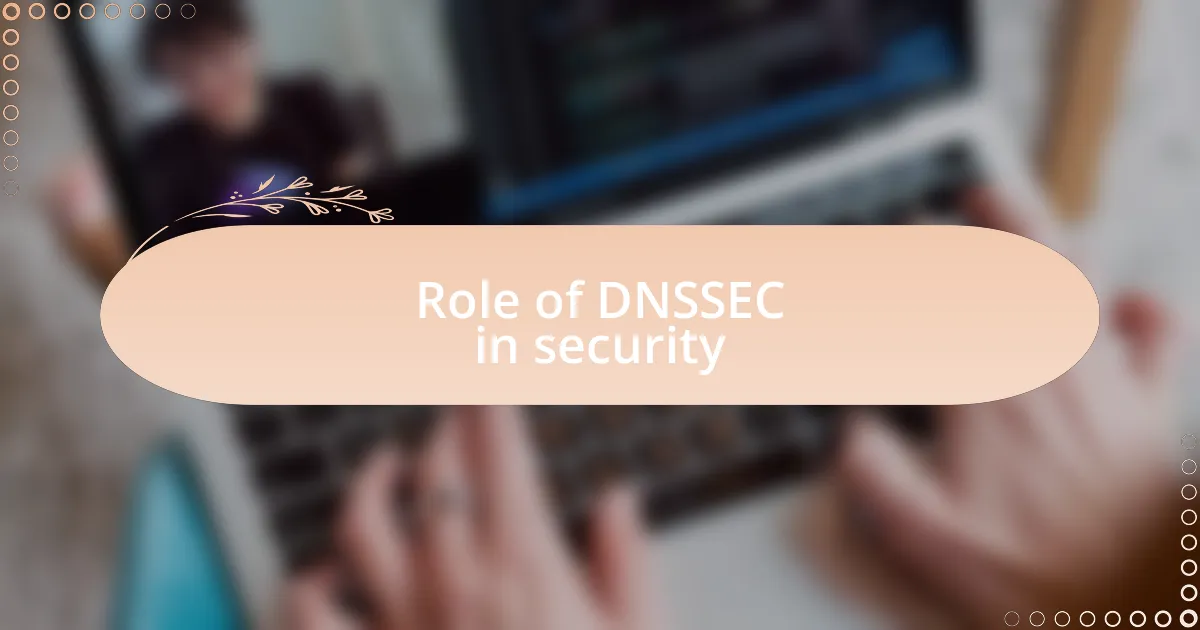
Role of DNSSEC in security
DNSSEC, or Domain Name System Security Extensions, plays a vital role in safeguarding the integrity of DNS. When I first learned about DNSSEC, I was struck by how it acts like a security guard, ensuring that the responses we receive from DNS queries haven’t been tampered with. Imagine clicking on what you think is a safe website, only to find out it has been hijacked! This scenario is precisely what DNSSEC aims to prevent, providing an additional layer of security that is crucial in our increasingly connected world.
What truly resonated with me was when I witnessed, firsthand, a cyberattack that leveraged DNS spoofing. It was alarming to see how attackers redirected users to malicious sites, putting not only data but also sensitive information at risk. DNSSEC mitigates such vulnerabilities by employing digital signatures to authenticate DNS data. This means that when a DNSSEC-protected domain resolves, users can trust they are actually reaching the intended destination rather than a deceptive one. Can you imagine needing to rely on that assurance every time you enter a web address?
Moreover, the implementation of DNSSEC offers a pathway to building greater trust within online interactions. I fondly recall a discussion with colleagues about how users increasingly seek out secure sites, often looking for the signs of trustworthiness, like HTTPS. By deploying DNSSEC, businesses can add another layer of credibility, showing users that they take security seriously. Isn’t it reassuring knowing that there are measures in place designed to protect users from unseen threats lurking in cyberspace?
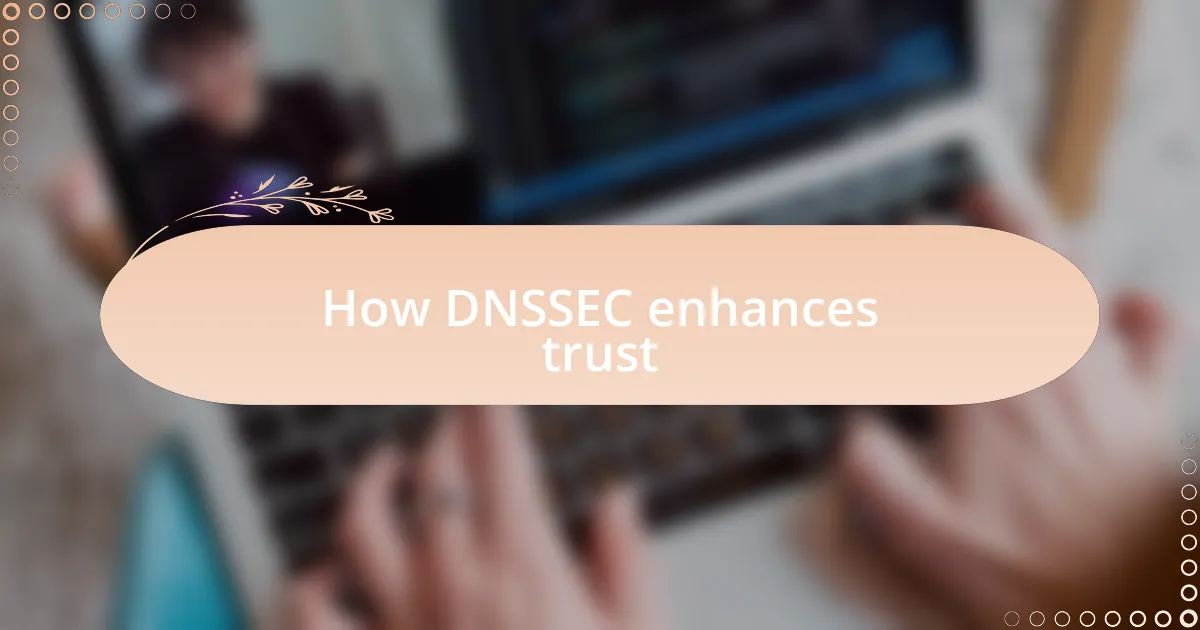
How DNSSEC enhances trust
When I think about how DNSSEC enhances trust, I can’t help but remember a time when I recommended a friend to a website for important legal documents. He was nervous about the accuracy of the site he relied on, but I was able to reassure him that it was DNSSEC protected. The relief on his face when he understood that the digital signatures confirmed the site’s authenticity was priceless. This clarity fosters a bond of trust that is essential in our online experiences.
Trust is built on confidence, and DNSSEC provides that confidence by ensuring that users can verify the legitimacy of a domain. I once participated in a web project for a nonprofit organization, and we made it a priority to implement DNSSEC. The feedback we received from our donors was overwhelmingly positive, as they felt secure knowing their contributions wouldn’t be diverted to a malicious site. This example highlights how organizations can strengthen their reputation by taking proactive security measures.
Every time I encounter a warning about an unverified site, I reflect on the importance of DNSSEC in alleviating those fears. The idea that someone could poison DNS responses and lead users astray is chilling. When I see the DNSSEC seal on a website, it’s like a reassuring handshake, silently saying, “You can trust me.” Isn’t it fascinating how a simple extension can bolster the very foundation of trust in digital interactions?
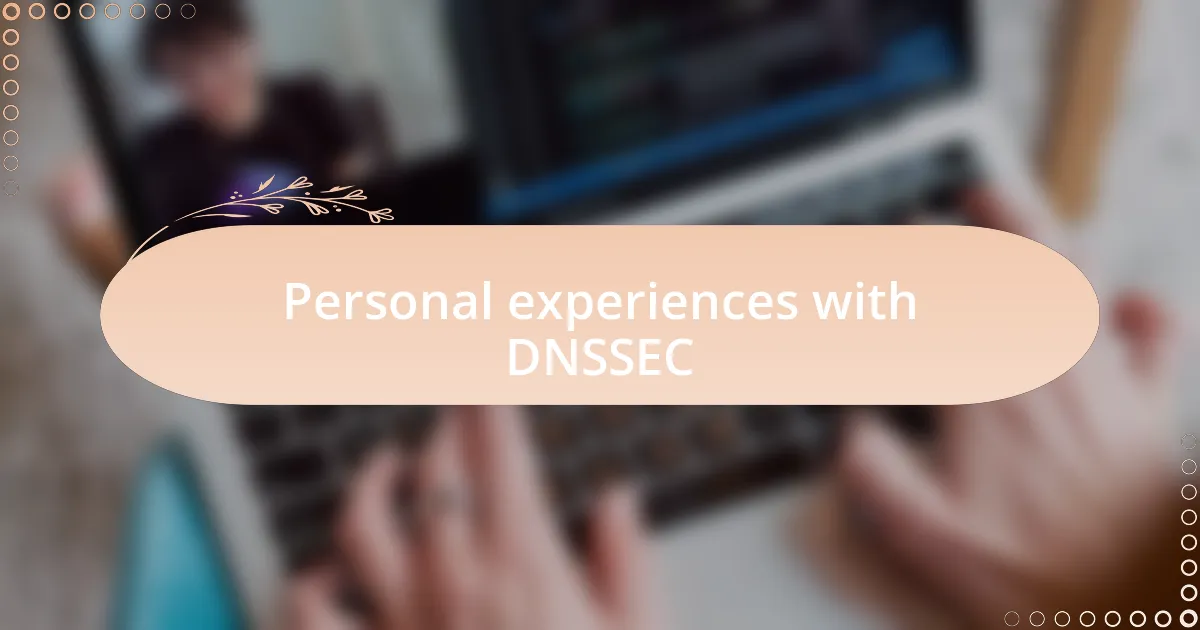
Personal experiences with DNSSEC
One of my most memorable experiences with DNSSEC came during a cybersecurity workshop I attended. As we explored various security protocols, the instructor highlighted how DNSSEC prevents cache poisoning. I remember jotting down that moment in my notebook, realizing just how critical this technology is in safeguarding our internet experiences. It gave me a sense of empowerment knowing I could help others understand these concepts.
In a personal project where I set up a small business website, implementing DNSSEC was a non-negotiable step. I vividly recall the moment I got the green light that the DNSSEC setup was successful. It felt like securing a digital vault; I knew my customers’ data was safer, and I had taken meaningful action to protect them. That security ultimately translated into increased customer confidence.
Another time, during a routine check of a blog I follow, I noticed the site had enabled DNSSEC. I felt an instant sense of relief wash over me. It made me wonder: how many people realize the importance of these protections? For me, knowing that the site was verified was akin to entering a familiar, well-lit room when stepping inside a new house. It made the online world feel a bit more welcoming and secure.
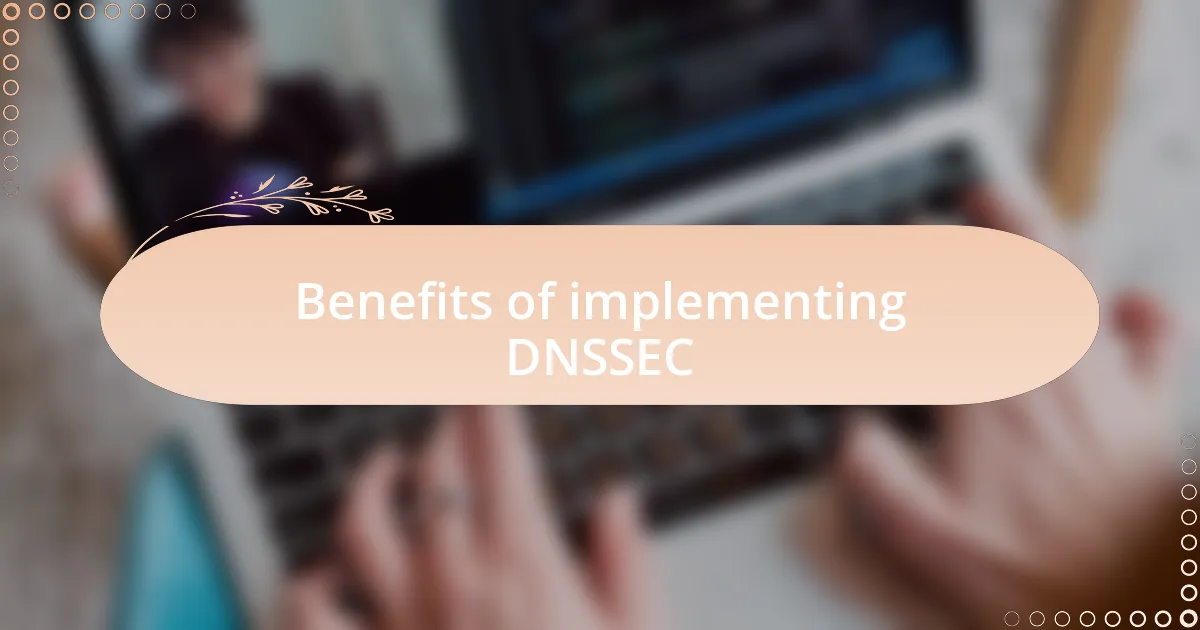
Benefits of implementing DNSSEC
Implementing DNSSEC offers a significant advantage by enhancing online security. I remember a time when I visited a friend’s website that had recently adopted DNSSEC. Seeing the added layer of trust in the verification process gave me peace of mind, knowing that the risk of attackers tampering with the website’s DNS did not threaten the integrity of my visit. How reassuring is it to navigate the internet knowing that your connections are safeguarded?
Another benefit I’ve observed firsthand is the boost in user trust. I once attended a seminar where a presenter shared a case study of a large e-commerce site that enabled DNSSEC. The evident rise in customer engagement due to improved trustworthiness was striking. It’s fascinating to think about how a strong security protocol can encourage people to interact and transact, ultimately translating into business growth.
Furthermore, I recall helping a local charity transition to DNSSEC. The excitement among the team was palpable as they realized this move would protect their donors from phishing attacks. It’s moments like these that reinforce my belief that implementing DNSSEC isn’t just a technical choice; it’s a pivotal commitment to a secure and reliable online experience for everyone involved.
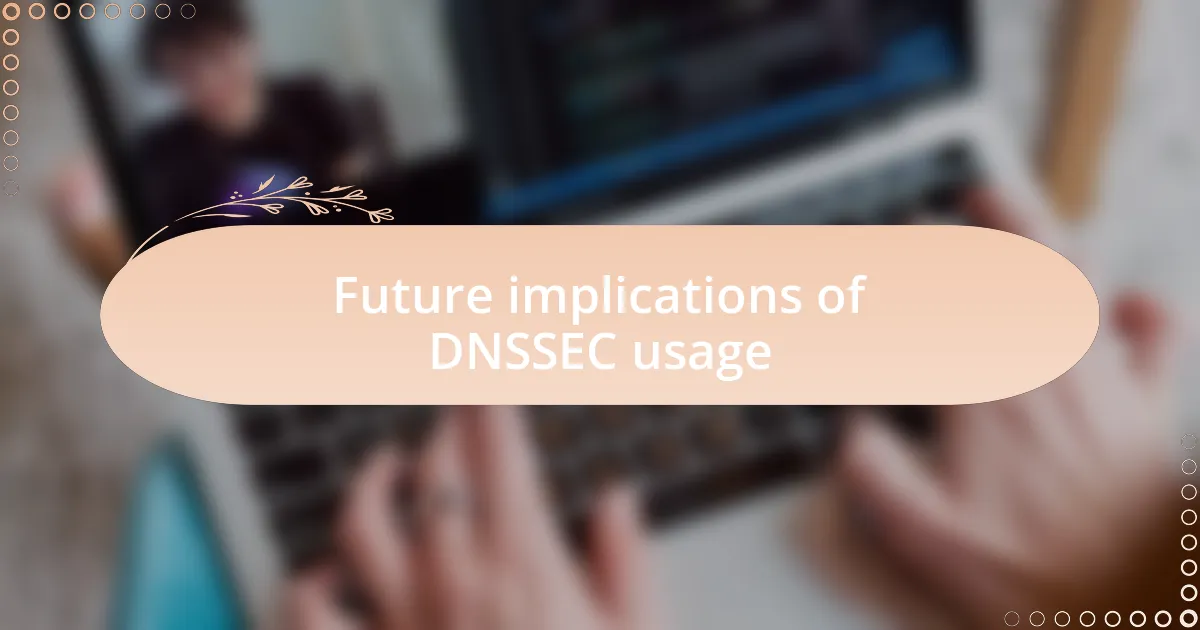
Future implications of DNSSEC usage
As I think about the future implications of DNSSEC usage, I can’t help but envision a world where online transactions become inherently safer. Just imagine a time when all websites implement DNSSEC as a standard practice. This shift could drastically reduce the prevalence of cyberattacks that exploit DNS vulnerabilities, creating an environment where users feel more confident while engaging in e-commerce. Isn’t that a future worth striving for?
In my experience, the adoption of DNSSEC could also lead to a more resilient internet. A few months ago, I participated in an online panel discussing internet security trends. One expert shared a compelling vision: in a DNSSEC-enabled future, even smaller organizations would have an equal footing in cybersecurity, diminishing the gap between larger corporations and smaller entities. Can you picture how empowering that would be for small businesses trying to establish their online presence?
Furthermore, I’ve noticed a growing trend in regulatory bodies recognizing the importance of DNSSEC. I recall a conversation with a colleague who works in compliance. He mentioned that future regulations might not only incentivize DNSSEC adoption but may even mandate it for certain sectors. This shift could reshape how we approach internet security on a broader scale, ensuring that every user’s experience is safeguarded and that trust is woven into the fabric of our digital interactions.